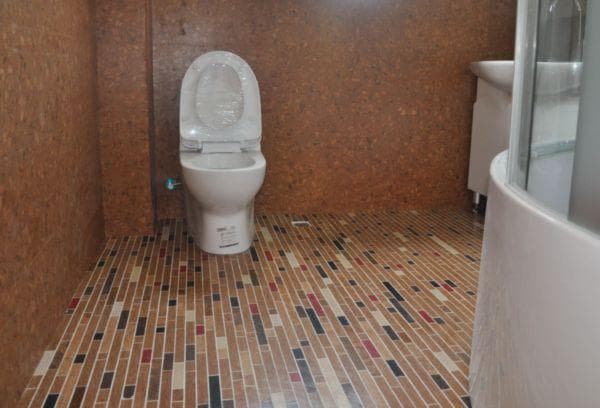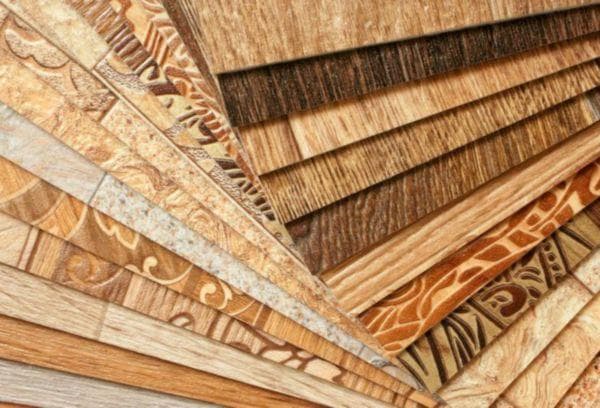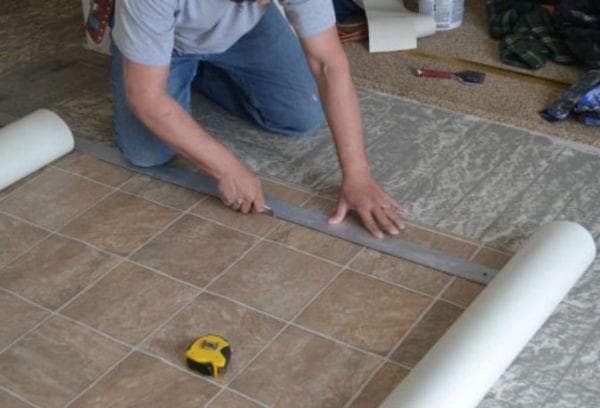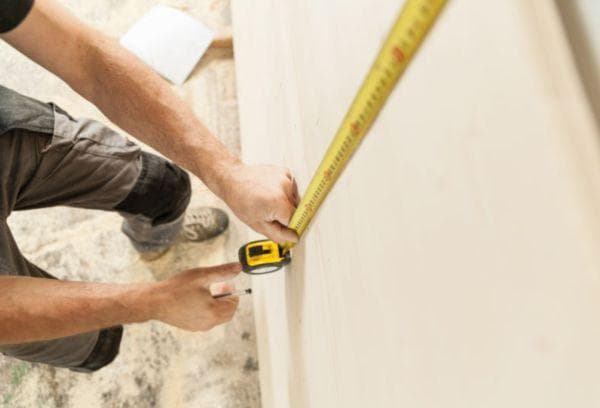Decorating the walls in the bathroom with linoleum instead of tiles
Today, linoleum for bathroom walls is not often used. Materials for finishing bathroom walls should have good moisture resistance, ease of maintenance, durability, and attractive appearance. One of the most common materials that meet these characteristics is ceramic tiles.
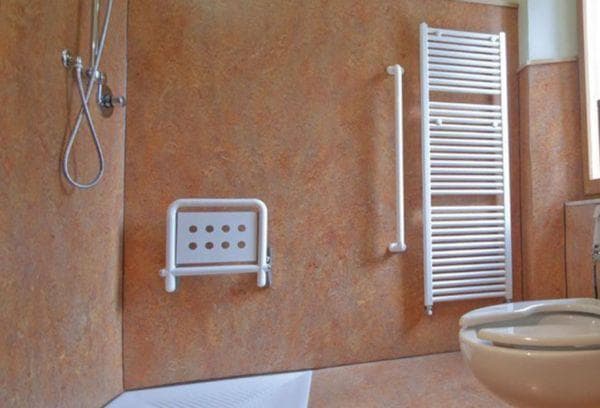
However, not so long ago a new type of linoleum appeared on the construction market - wall linoleum. In terms of its characteristics, it is not inferior to ceramic tiles, and many have already appreciated this finishing option.
Pros and cons of using linoleum in the bathroom
The main competitor of linoleum is ceramic tiles, which has a number of disadvantages:
- Tendency to form mold in joints, which is difficult to clean and spoils the appearance of the room.
- High cost of laying the material.
- A labor-intensive installation process that requires sufficient experience and special tools.
When covering bathroom walls with linoleum, the above problems do not arise: the material covers the surface with a solid sheet, and the joints between the sheets are sealed with a sealant that reliably protects against mold and moisture. The process of covering walls with linoleum does not take much effort and time, so even a woman can make such repairs.
The material in question has other advantages:
- Presentable appearance.
- Hygiene, the ability to use any household chemicals in the cleaning process, including abrasive cleaning powders.
- Completely waterproof.
- Resistance to deformation under temperature changes and high humidity.
The disadvantages of linoleum used as a finishing material for walls include:
- High cost - on average, 1 m² of such linoleum costs 500-800 rubles.
- A small assortment - unlike Western countries, in our country wall linoleum is not yet so widespread. In this regard, when selecting the desired color or pattern, certain difficulties may arise.
Which linoleum to use for walls?
When choosing wall linoleum, you need to understand how it differs from floor linoleum. The structure of the material intended for wall decoration is more dense and elastic, it is not equipped with a porous backing and has a thickness of 1-1.5 mm.
The small thickness allows you to significantly reduce the weight of the finish, and thanks to the increased elasticity, you can avoid the formation of creases and simplify the process of gluing structures of any configuration.
The increased strength of the material prevents scratches and mechanical damage even with a strong impact.
Therefore, when buying wall linoleum, it is recommended to give preference to materials with a more elastic and dense structure.
In terms of color and texture for the bathroom, it is better to use smooth or rough linoleum that imitates marble, tiles or wood.
What do you need for work?
First of all, you need to make calculations and determine how much material will be needed to finish the bathroom, depending on its dimensions.
Wall linoleum is sold in rolls. The width of the canvases is usually 200 mm, and the length is 30 m.With a room height of 3 m, one such roll is enough for 10 strips, which can be used to cover a room 4:5 m wide. However, when performing calculations, you need to take into account the location of the pattern - when adjusting it, there is often a lot of waste left.
Before starting work, you will need to prepare the following materials and tools:
- Roulette.
- Pencil.
- Notched trowel.
- Glue.
- Knife for cutting linoleum.
- Welding.
- Rubber roller or plastic spatula for smoothing linoleum.
- Aluminum corners.
- Sealant.
How to finish correctly
First you need to prepare the walls - clean them of old finishing and protruding parts of the plaster. Then the surface is leveled using cement mortar or putty, and a primer is applied. Particular attention must be paid to the corners. If the walls in the bathroom are very crooked, you can use plasterboard sheets attached to profiles to level them.
Then they start gluing. The procedure is performed in the following sequence:
- Using a tape measure and a pencil, markings are applied to the wall.
- Then you will need to cut out the finishing material according to the measurements taken.
- Using a notched trowel, glue is applied to the surface of the wall and the prepared piece of linoleum is immediately applied.
- Then the finishing surface is pressed tightly against the wall, smoothing it with a roller or plastic spatula. It is necessary to smooth out in the direction from the center to the edges - this will help expel the air and ensure the tightest possible fit. The edges of the canvases are especially carefully pressed at the joints. If necessary, they are folded back and additionally treated with an adhesive composition.
- For more reliable fixation, a thin strip of sealant is laid in the inner corners of the room, an aluminum corner is applied and secured with self-tapping screws. Excess sealant that protrudes is removed immediately.
- The joints between the sheets are sealed using a welding cord or adhesive.
In the bathroom where the renovation was carried out, close the windows and doors tightly to protect from drafts, and leave the room until the glue has completely dried. The time during which it should dry is indicated by the manufacturer on the packaging.
Another advantage of wall linoleum is its versatility. They can be used to completely cover all walls or make a decorative panel on one or several parts of it. If desired, only the lower surfaces of the walls can be decorated with this material, simulating panels. In a brightly lit room, you can use dark shades of finishing, while for a small bath with insufficient light, it is better to stick light-colored linoleum.
